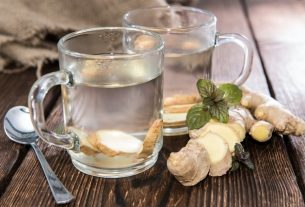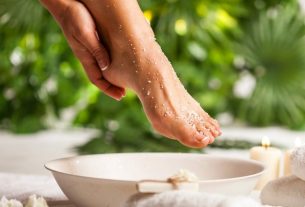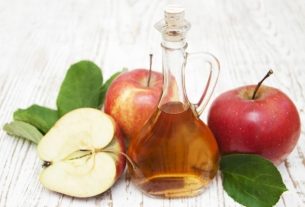To naturally alleviate poor circulation, you can drink diuretic teas, such as green tea or parsley tea, drink more fluids during the day, reduce salt intake, consume cayenne pepper and increase your consumption of foods rich in omega-3. 3, citrus fruits and dark green vegetables.
Furthermore, one of the best ways to alleviate poor circulation is to simply move your legs and arms during the day, to facilitate blood circulation and avoid the accumulation of fluids that can cause swelling.
Poor circulation can arise due to a natural aging process of the body, but it can also occur due to diseases such as peripheral arterial disease, diabetes, obesity or smoking, with the main symptoms being swelling of the legs, cold hands and feet and cramps, for example. example. Check out other symptoms of poor circulation.

Natural Treatment Options
Some natural treatment options for poor circulation are:
1. Drink more fluids
Drinking fluids during the day can help improve and prevent poor circulation, as when the body is not hydrated enough, the blood does not circulate properly, which can cause fluid retention and swelling in the legs, feet or hands. .
Therefore, it is important to drink at least 8 to 10 glasses of water a day or juice with fruits that help improve blood circulation. See all the juice options for poor circulation and how to prepare them.
2. Use cayenne pepper
A great strategy to improve poor circulation is to use cayenne pepper, as it is rich in capsaicin, a substance that improves blood flow to tissues, reduces blood pressure and stimulates the release of nitric oxide responsible for dilating blood vessels, making makes blood flow more easily through veins and arteries.
Some studies show that increasing the intake of cayenne pepper improves circulation and the resistance of blood vessels, in addition to reducing the accumulation of fatty plaques in the arteries.
A good way to use cayenne pepper is to add a pinch to a liter of water and drink it throughout the day, being careful not to add too much, as the drink can become very spicy. Another option is to put 1 teaspoon of cayenne pepper powder in 1 liter of olive oil and use it to season the salad.
3. Drink diuretic tea
Diuretic teas such as green tea, parsley tea or horsetail tea have natural diuretic, antioxidant and anti-inflammatory properties due to the presence of flavonoids, caffeine and potassium, improving poor circulation and helping to eliminate excess fluid that causes swelling in your hands, legs or feet, for example.
To obtain the benefits of diuretic teas, you must choose one of the teas to drink and drink throughout the day. See how to prepare diuretic teas.
4. Increase your consumption of omega 3
Omega 3 is a type of good fat that has a powerful anti-inflammatory action, promoting the release of nitric oxide, a substance that increases the dilation of blood vessels, improving blood flow, which improves circulation.
Furthermore, omega 3 also lowers blood pressure and helps inhibit the accumulation of fats in veins and arteries, preventing the development of cardiovascular diseases such as atherosclerosis, heart attack or stroke.
An excellent way to increase your consumption of omega 3 is to eat salmon, tuna or sardines at least 3 times a week or chia seeds and flaxseeds, chestnuts, walnuts and olive oil every day. Another option is to consume an omega 3 supplement in the form of capsules, which are sold in pharmacies, drugstores and nutrition stores. Check out more foods rich in omega 3.
5. Eat more dark green vegetables
Dark green vegetables, such as spinach, watercress, coriander, parsley and kale, are rich in nitrates, a substance that is transformed into nitric oxide in the body, and which acts by dilating blood vessels, allowing blood to flow more easily, which helps combat poor circulation.
Therefore, you should consume dark green vegetables every day in salads, juices or soups, for example. Check out the list of other foods that help improve blood circulation.
6. Eat more citrus fruits
Citrus fruits such as orange, lemon and grapefruit are rich in vitamin C and flavonoids, which are powerful antioxidants that help improve circulation by reducing damage to blood vessels caused by free radicals, reducing blood pressure and stiffness of the arteries, in addition to improving blood flow and the production of nitric oxide responsible for relaxing veins and arteries.
The ideal is to consume at least two types of fresh citrus fruits every day or in juices and smoothies. See how to prepare juices for poor circulation.
7. Decrease salt consumption
Ingesting large amounts of salt in your diet can make blood circulation difficult because salt contains a lot of sodium that retains water and, therefore, if it is present in large quantities in the body, it increases fluid retention, leading to the appearance of swelling in the legs, in the feet, ankles, arms or hands.
A good way to reduce salt intake is to use low-sodium salt or use aromatic herbs to reduce salt intake or avoid adding salt to meals.
8. Take a bath with Epsom salts
Epsom salts are rich in magnesium sulfate which is easily absorbed by the skin, facilitating blood flow, reducing symptoms of poor circulation such as swelling or pain in the legs or feet, for example.
This soaking bath is very easy to prepare and allows you to quickly relieve pain and swelling at the end of the day, as well as promoting relaxation.
A good way to use Epsom salt is to make a foot bath by adding ½ cup of Epsom salts to 2 to 3 liters of warm water or enough water to cover your feet and reach at least the middle of your foot. calf. Dilute the salts well, stirring the water with your hand and placing your feet in the water for around 15 minutes. This process can be done up to 3 times a week.
9. Move your legs and arms
Practicing light physical activities such as walking or water aerobics, for example, stimulate blood circulation and help reduce and prevent poor circulation. Furthermore, moving your body helps reduce swelling in your legs, feet, hands or arms, as it improves blood and lymphatic circulation.
One way to move your legs, if you work sitting for a long time, is to walk a little every hour, within the company or walk a block at lunch time, for example. However, if the job requires standing for a long time, it is important to flex your knees and ankles every hour or stand up on your toes to help your calves pump blood from your legs to your heart. To move your arms, you should raise your arms up every hour, opening and closing your hands to help blood circulation and avoid swelling due to poor circulation.
When to go to the doctor
It is important that the doctor is consulted when certain symptoms appear, such as:
- Sudden swelling of the legs, feet or arms;
- Swelling in only one foot or one hand;
- Redness of the swollen foot or hand;
- Shortness of breathe;
- Cough or expectoration;
- Fever;
- Tingling.
In these cases, the doctor may order tests such as blood tests or Doppler ultrasound, for example, to identify the source of poor circulation and recommend the most appropriate treatment. Find out how poor circulation is treated.

Sign up for our newsletter and stay up to date with exclusive news
that can transform your routine!
Warning: Undefined array key "title" in /home/storelat/public_html/wp-content/plugins/link-whisper-premium/templates/frontend/related-posts.php on line 12
Warning: Undefined array key "title_tag" in /home/storelat/public_html/wp-content/plugins/link-whisper-premium/templates/frontend/related-posts.php on line 13



